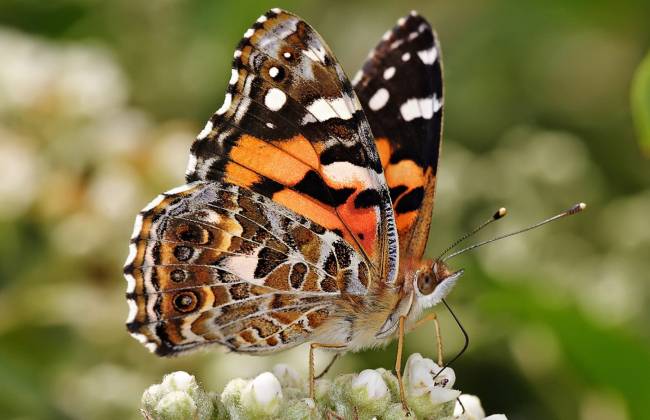Most of the world’s backyards and meadows are home to the painted lady butterfly, also known as the cosmopolitan or thistle butterfly. Raising these butterflies in elementary school classrooms is a popular science activity for children.
Table of Contents
Description
The painted lady’s wings are adorned with splashes and dots of color. The upper side of an adult butterfly’s wings is orange and brown. The forewing’s leading edge appears black with a prominent white bar and smaller white spots. In shades of brown and gray, the underside of the wings is noticeably duller. Four small eyespots can be seen on the hindwing of a butterfly at rest with its wings folded together. Compared to some other brush-footed butterflies like monarchs, painted ladies reach a width of 5-6 centimeters.
As their appearance changes with each instar, painted lady caterpillars are more difficult to identify. Early instars appear worm-like, with light gray bodies and a darker, bulbous head. The larvae develop visible spines as they mature, along with a dark body mottled with white and orange markings. In the final instar, the spines remain, but the color is lighter. On the leaf of the host plant, the first few instars live in a silken web.
Vanessa cardui is an irruptive migrant, a species that migrates occasionally without regard to geography or season. They live year-round in the tropics; in cooler climates, they appear in spring and summer. There are some years when painted ladies migrate north temporarily to expand their range when southern populations reach large numbers or the weather conditions are right. Sometimes, these migrations occur in phenomenal numbers, filling the skies with butterflies. However, adults who reach colder regions will not survive the winter. It is rare for painted ladies to migrate south.

Classification
Animalia is a kingdom
Arthropoda is a phylum
The class Insecta
The Lepidoptera order
Nymphalidae Family
Vanessa is a genus
Vanessa cardui is a species
Diet
In particular, the adult painted lady nectars on the composite flowers of the Asteraceae plant family. Thistle, aster, cosmos, blazing star, ironweed, and joe-pye weed are favorite nectar sources. Thistle, mallow, and hollyhock are among the host plants of painted lady caterpillars.
Life Cycle
The painted lady butterfly undergoes four stages of metamorphosis: egg, larva, pupa, and adult.
- Egg – Mint green, barrel-shaped eggs are laid singly on host plant leaves and hatch in 3-5 days.
- A caterpillar has five instars over a period of 12-18 days.
- Chrysalis – The pupa stage lasts about ten days.
- Butterflies live for just two weeks as adults.
Special Adaptations and Defenses
Her mottled colors resemble military camouflage and provide effective protection from predators. Caterpillars hide in their silk nests.
Habitat
A painted lady lives in open meadows and fields, disturbed areas and roadsides, and generally anywhere with a good source of nectar and host plants.
Range
It is the world’s most widely distributed butterfly, found on all continents except Australia and Antarctica. As a result of this wide distribution, the painted lady is sometimes called the cosmopolitan or the cosmopolitan lady.
